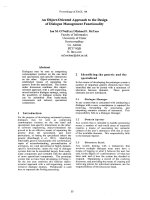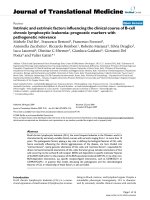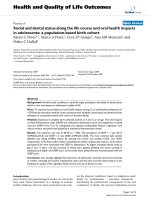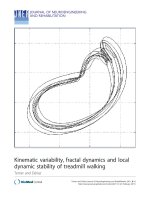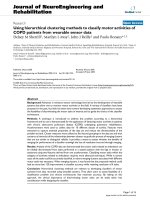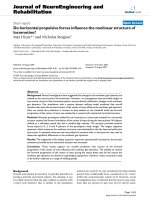Báo cáo hóa học: " A fixed point approach to the Hyers-Ulam stability of a functional equation in various normed spaces" pptx
Bạn đang xem bản rút gọn của tài liệu. Xem và tải ngay bản đầy đủ của tài liệu tại đây (347.56 KB, 14 trang )
RESEARCH Open Access
A fixed point approach to the Hyers-Ulam
stability of a functional equation in various
normed spaces
Hassan Azadi Kenary
1
, Sun Young Jang
2
and Choonkil Park
3*
* Correspondence: baak@hanyang.
ac.kr
3
Department of Mathematics,
Research Institute for Natural
Sciences, Hanyang University, Seoul
133-791, Korea
Full list of author information is
available at the end of the article
Abstract
Using direct method, Kenary (Acta Universitatis Apulensis, to appear) proved the
Hyers-Ulam stability of the following functional equation
f (mx + ny)=
(m + n)f(x + y)
2
+
(m − n)f(x − y)
2
in non-Archimedean normed spaces and in random normed spaces, where m, n are
different integers greater than 1. In this article, using fixed point method, we prove
the Hyers-Ulam stability of the above functional equation in various normed spaces.
2010 Mathematics Subject Classification: 39B52; 47H10; 47S40; 46S40; 30G06;
26E30; 46S10; 37H10; 47H40.
Keywords: Hyers-Ulam stability, non-Archimedean normed space, random normed
space, fuzzy normed space, fixed point method
1. Introduction
A classical question in the theory of functional equations is the following: “When is it
true that a function which approximately satisfies a functional equation must be close
to an exact solution of the equation?” If the problem accepts a solution, then we say
that the equation is stable. The first stability problem concerning group homomorph-
isms was raised by Ulam [1] in 1940. In the following year, Hyers [2] gave a positive
answer to the above question for additive groups under the assumption that the groups
are Banach spaces. In 1978, Rassias [3] proved a generalization of Hyers’ theorem for
additive mappings. Furthermore, in 1994, a general ization of the Rassias’ theorem was
obtained by Găvruta [4] by replacing the bound ε (||x||
p
+||y||
p
) by a general control
function j(x, y).
The functional equation f(x + y)+f(x - y)=2f(x)+2f (y)iscalledaquadratic func-
tional equation. In particular, every solution of the quadratic functional equation is
said to be a quadratic mapping. In 1983, the Hyers-Ulam stability problem for the
quadratic functional equation was proved by Skof [5] for mappings f : X ® Y, where X
is a normed space and Y is a Banach space. In 1984, Cholewa [6] noticed that th e the-
orem of Skof is still true if the relevant domain X is replaced by an Abelian group and,
in 2002, Czerwik [7] proved the Hyers-Ulam stability of the quadratic functional
equation.
Kenary et al. Fixed Point Theory and Applications 2011, 2011:67
/>© 2011 Kenary et al; licensee Springer. This is an Open Access article distributed under the terms of the Creative Commons Attribution
License (http ://cr eativecommons.or g/licenses/by/2.0), which permits unrestricted use, distribution, and reproduction in any medium,
provided the original wo rk is p roperly cited.
The stability problems of several functional equ ations have been extensively investi-
gated by a number of authors, and there are many interesting results concerning this
problem (see [8-12]).
Using fixed point method, we prove the Hyers-Ulam stability of the following func-
tional equation
f (mx + ny)=
(m + n)f(x + y)
2
+
(m − n)f(x − y)
2
(1)
in various spaces, which was introduced and investigated in [13].
2. Preliminaries
In this section, we give some definitions and lemmas for the main results in this
article.
A valuation is a function | · | from a field
K
into [0, ∞)suchthat,forall
r
,
s ∈
K
,the
following conditions hold:
(a) |r| = 0 if and only if r =0;
(b) |rs|=|r||s|;
(c) |r + s| ≤ |r|+|s|.
A field
K
is called a valued field if
K
carries a v aluation. The usual absolute values of
ℝ and ℂ are examples of valuations.
In 1897, Hensel [14] has introduced a normed space which does not have the Archi-
medean property.
Let us consider a v aluation which satisfies a stronger condition than the triangle
inequality. If the triangle inequality is replaced by
|
r + s
|
≤ max
{|
r
|
,
|
s
|}
for all
r
,
s ∈
K
then the function | · | is called a non-Archimedean valuation and
the field is called a non-Archimedean field. Clearly, |1| = | -1| = 1 and |n| ≤ 1forall
n Î N.
A trivial example of a non-Archimedean valuation is the function | · | taking ev ery-
thing except for 0 into 1 and |0| = 0.
Definition 2.1.LetX be a vector space over a field
K
with a non-Archimedean
valuation | · |. A function || · || : X ® [0, ∞ )iscalledan on-Archimed ean norm if the
following conditions hold:
(a)||x|| = 0 if and only if x = 0 for all x Î X;
(b)||rx|| = |r|||x|| for all
r
∈ K
and x Î X;
(c) the strong triangle inequality holds:
|
|x +
y
|| ≤ max{||x||, ||
y
||
}
for all x, y Î X. Then (X, || · ||) is called a non-Archimedean normed space.
Definition 2.2. Let {x
n
} be a sequence in a non-Archimedean normed space X.
(a) The sequence {x
n
}iscalledaCauchy sequence if, for any ε >0, there is a positive
integer N such that ||x
n
- x
m
|| ≤ ε for all n, m ≥ N.
(b) The sequence {x
n
}issaidtobeconvergent if, for any ε > 0, there are a positive
integer N and x Î X such that ||x
n
- x|| ≤ ε for all n ≥ N. Then the point x Î X is
called the limit of the sequence {x
n
}, which is denote by lim
n®∞
x
n
= x.
Kenary et al. Fixed Point Theory and Applications 2011, 2011:67
/>Page 2 of 14
(c) If every Cauchy sequen ce in X converges, then the n on-Archime dean normed
space X is called a non-Archimedean Banach space.
It is noted that
|
|x
n
− x
m
|| ≤ max{||x
j
+1
− x
j
: m ≤ j ≤ n − 1
}
for all m, n ≥ 1 with n>m.
In the sequel (in random stability section), we adopt the usual terminology, notions,
and conventions of the theory of random normed spaces as in [15].
Throughout this article (in random stability section), let Γ
+
denote the set of all
probability distribution f unctions F : ℝ ∪ [-∞,+∞] ® [0,1] such that F is left-continu-
ous and nondecreasing on ℝ and F(0) = 0, F(+∞) = 1. It is clear that the set D
+
={F Î
Γ
+
: l
-
F(-∞)=1},where
l
−
f
(
x
)
= lim
t→x
−
f
(
t
)
, is a subset of Γ
+
.ThesetΓ
+
is partially
ordered by the usual point-wise ordering of functions, i.e., F ≤ G if and only if F(t) ≤ G
(t) for all t Î ℝ. For any a ≥ 0, the element H
a
(t)ofD
+
is defined by
H
a
(t )=
0ift ≤ a,
1ift > a
.
We can easily show that the maximal element in Γ
+
is the distribution function
H
0
(t).
Definition 2.3. [15] A function T :[0,1]
2
® [0, 1] is a continuous triangular norm
(briefly, a t-norm) if T satisfies the following conditions:
(a) T is commutative and associative;
(b) T is continuous;
(c) T(x,1)=x for all x Î [0, 1];
(d) T(x, y) ≤ T(z, w) whenever x ≤ z and y ≤ w for all x, y, z, w Î [0, 1].
Three typical examples of continuous t-norms are as follows: T(x, y)=xy, T(x, y)=
max{a + b - 1, 0}, and T(x, y) = min(a, b).
Definition 2.4.[16]Arando m normed space (briefly, RN-space) is a triple (X, μ, T),
where X is
a vector space, T is a continuous t-norm, and μ : X ® D
+
is a m apping
such that the following conditions hold:
(a) μ
x
(t)=H
0
(t) for all x Î X and t>0 if and only if x =0;
(b)
μ
αx
(t )=μ
x
(
t
|
α
|
)
for all a Î ℝ with a ≠ 0, x Î X and t ≥ 0;
(c) μ
x+y
(t + s) ≥ T ( μ
x
(t), μ
y
(s)) for all x, y Î X and t, s ≥ 0.
Definition 2.5. Let (X, μ, T) be an RN-space.
(1) A sequence {x
n
}inX is said to be convergent to a point x Î X (write x
n
® x as
n ® ∞)if
lim
n→∞
μ
x
n
−x
(t )=
1
for all t>0.
(2) A sequence {x
n
}inX is called a Cauchy sequence in X if
lim
n→∞
μ
x
n
−x
m
(t )=
1
for
all t>0.
(3) The RN-space (X, μ, T)issaidtobecomplete if every Cauchy sequence i n X is
convergent.
Theorem 2.1. [15]If (X, μ, T) is an RN-space and {x
n
} is a sequence such that x
n
®
x, then
lim
n→∞
μ
x
n
(t )=μ
x
(t )
.
Definition 2.6.[17]Let X be a real vector space. A function N : X × ℝ ® [0, 1] is
called a fuzzy norm on X if for all x, y Î X and all s, t Î ℝ,
(N1) N(x, t)=0for t ≤ 0;
(N2) x =0if and only if N(x, t)=1for all t >0;
Kenary et al. Fixed Point Theory and Applications 2011, 2011:67
/>Page 3 of 14
(N3)
N( cx, t)=N(x,
t
|
c
|
)
if c ≠ 0;
(N4) N(x + y, s + t) ≥ min{N(x, s), N(y, t)};
(N5) N(x,.) is a non-decreasing function of ℝ and lim
t®∞
N (x, t)=1;
(N6) for x ≠ 0, N(x,.) is continuous on ℝ.
The pair (X, N) is called a fuzzy normed vector space. The properties of fuzzy
normed vector space are given in [18].
Example 2.1. Let (X, || · ||) be a normed linear space and a, b >0. Then
N( x , t)=
αt
αt+βx
t > 0, x ∈
X
0 t ≤ 0, x ∈ X
is a fuzzy norm on X.
Definition 2.7. [17]Let (X, N) be a fuzzy normed vector space. A sequence {x
n
} in X is
said to be convergent or converge if there exists an x Î X such that lim
t®∞
N ( x
n
- x, t)
=1for all t >0. In this case, x is called the limit of the sequence {x
n
} in X and we
denote it by N - lim
t®∞
x
n
= x.
Definition 2.8. [17]Let (X, N) be a fuzzy normed vector space. A sequence {x
n
} in X is
called Cauchy if for each ε >0 and each t >0 there exists an n
0
Î N such that for all n
≥ n
0
and all p >0,we have N (x
n+p
- x
n
, t)>1-ε.
It is well known that every convergent sequence in a fuzzy normed vector space is
Cauchy. If each Cauchy sequence is convergent, then the fuzzy norm is said to be
complete and the fuzzy normed vector space is called a fuzzy Banach space.
Example 2.2. Let N : ℝ × ℝ ® [0, 1] be a fuzzy norm on ℝ defined by
N( x , t)=
t
t+|x|
t > 0
0 t ≤ 0
.
Then (ℝ, N) is a fuzzy Banach space.
We say th at a mapping f : X ® Y between fuzzy normed vector spaces X and Y is
continuous at a point x Î X if for each sequence {x
n
}convergingtox
0
Î X, then the
sequence {f(x
n
)} converges to f (x
0
). If f : X ® Y is continuous at each x Î X,thenf :
X ® Y is said to be continuous on X [19].
Throughout this article, assume that X is a vector space and that (Y, N)isafuzzy
Banach space.
Definition 2.9.LetX be a set. A function d : X × X ® [0, ∞] is called a generalized
metric on X if d satisfies the following conditions:
(a) d(x, y) = 0 if and only if x = y for all x, y Î X;
(b) d(x, y)=d(y, x) for all x, y Î X;
(c) d(x, z) ≤ d(x, y)+d(y, z)
for all x, y, z Î X.
Theorem 2.2. [20,21]Let (X, d) be a complete generalized metric space and J : X ® X
be a strictly contractive mapping with Lipschitz constant L < 1. Then, for all x Î X,
either
d
(
J
n
x, J
n+1
x
)
=
∞
for all non-negative integers n or there exists a positive integer n
0
such that
(a) d(J
n
x, J
n+1
x)<∞ for all n
0
≥ n
0
;
(b) the sequence {J
n
x} converges to a fixed point y* of J;
(c) y* is the unique fixed point of J in the set
Y = {y ∈ X : d
(
J
n
0
x, y
)
< ∞
}
;
Kenary et al. Fixed Point Theory and Applications 2011, 2011:67
/>Page 4 of 14
(d)
d(y, y
∗
) ≤
1
1
−
L
d(y, Jy
)
for all y Î Y.
3. Non-Archimedean stability of the functional equation (1)
In this sect ion, using the fixed point alternative approach, we prove the Hyers-Ulam
stability of the functional equation (1) in non-Archimedean normed spaces.
Throughout this section, let X be a non-Archimedean normed space and Y acom-
plete non-Archimedean normed space. Assume that |m| ≠1.
Lemma 3.1. Let X and Y be linear normed spaces and f : X ® Y a mapping satisfy-
ing (1). Then f is an additive mapping.
Proof. Letting y = 0 in (1), we obtain
f
(
mx
)
= mf
(
x
)
for all x Î X. So one can show that
f
(
m
n
x
)
= m
n
f
(
x
)
for all x Î X and all n Î N.□
Theorem 3.1. Let ζ : X
2
® [0, ∞) be a function such that there exists an L <1 with
|m|ζ
(
x, y
)
≤ Lζ
(
mx, my
)
for all x, y Î X. If f : X ® Y is a mapping satisfying f(0) = 0 and the inequality
f (mx + ny) −
(m + n)f(x + y)
2
−
(m − n)f(x − y)
2
≤ ζ (x, y
)
(2)
for all x, y Î X, then there is a unique additive mapping A : X ® Y such that
f (x) − A(x) ≤
Lζ (x,0)
|
m
|
−
|
m
|
L
.
(3)
Proof. Putting y = 0 and replacing x by
x
m
in (2), we have
mf
x
m
− f (x)
≤ ζ
x
m
,0
≤
L
|
m
|
ζ (x,0
)
(4)
for all x Î X. Consider the set
S := {g : X → Y; g
(
0
)
=0
}
and the generalized metric d in S defined by
d(f , g)=inf
μ ∈ R
+
: g(x) − h(x) ≤ μζ(x,0), ∀x ∈ X
,
where inf ∅ =+∞. It is easy to show that (S, d) is complete (see [[22], Lemma 2.1]).
Now, we consider a linear mapping J : S ® S such that
J
h(x):=mh
x
m
for all x Î X. Let g, h Î S be such that d(g, h)=ε. Then we have
g
(
x
)
− h
(
x
)
≤ εζ
(
x,0
)
for all x Î X and so
Jg(x) − Jh(x) =
mg
x
m
− mh
x
m
≤|m|εζ
x
m
,0
≤|m|ε
L
|
m
|
ζ (x,0
)
Kenary et al. Fixed Point Theory and Applications 2011, 2011:67
/>Page 5 of 14
for all x Î X. Thus d(g, h)=ε implies that d(Jg, Jh) ≤ Lε. This means that
d(
Jg, J
h)
≤ L
d(
g,
h)
for all g, h Î S. It follows from (4) that
d(f , Jf ) ≤
L
|
m
|
.
By Theorem 2.2, there exists a mapping A : X ® Y satisfying the following:
(1) A is a fixed point of J, that is,
A
x
m
=
1
m
A(x
)
(5)
for all x Î X. The mapping A is a unique fixed point of J in the set
= {h ∈ S : d
(
g, h
)
< ∞}
.
This implies that A is a unique mapping satisfying (5) such that there exists μ Î (0, ∞)
satisfying
f
(
x
)
− A
(
x
)
≤ μζ
(
x,0
)
for all x Î X.
(2) d(J
n
f, A) ® 0asn ® ∞. This implies the equality
lim
n→∞
m
n
f
x
m
n
= A(x
)
for all x Î X.
(3)
d(f , A) ≤
d(
f
,J
f
)
1
−
L
with f Î Ω, which implies the inequality
d(f , A) ≤
L
|
m
|
−
|
m
|
L
.
This implies that the inequality (3) holds. By (2), we have
m
n
f
mx + ny
m
n
−
m
n
(m + n)f(
x+y
m
n
)
2
−
m
n
(m − n)f(
x−y
m
n
)
2
≤|m|
n
ζ
x
m
n
,
y
m
n
≤|m|
n
·
L
n
|
m
|
n
ζ (x, y)
for all x, y Î X and n ≥ 1 and so
A(mx + ny) −
(m + n)A(x + y)
2
−
(m − n)A(x − y)
2
=
0
for all x, y Î X.
On the other hand
mA
x
m
− A(x) = lim
n→∞
m
n+1
f
x
m
n+1
− lim
n→∞
m
n
f
x
m
n
=0
.
Therefore, the mapping A : X ® Y is additive. This completes the proof. □
Corollary 3.1. Let θ ≥ 0 and p be a real number w ith 0 <p<1. Let f : X ® Ybea
mapping satisfying f(0) = 0 and the inequality
Kenary et al. Fixed Point Theory and Applications 2011, 2011:67
/>Page 6 of 14
f (mx + ny) −
(m + n)f(x + y)
2
−
(m − n)f(x − y)
2
≤ θ (||x||
p
+ ||y||
p
)
(6)
for all x, y Î X. Then, for all x Î X,
A(x) = lim
n→∞
m
n
f
x
m
n
exists and A : X ® Y is a unique additive mapping such that
f (x) − A(x) ≤
|m|θ||x||
p
|
m
|
p+1
−
|
m
|
2
(7)
for all x Î X.
Proof. The proof follows from Theorem 3.1 if we take
ζ
(
x, y
)
= θ
(
||x||
p
+ ||y||
p
)
for all x, y Î X. In fact, if we choose L =|m|
1-p
, then we get the desired result. □
Theorem 3.2. Let ζ : X
2
® [0, ∞) be a function such that there exists an L <1 with
ζ (mx, my)
|
m
|
≤ Lζ (x, y
)
for all x, y Î X. Let f : X ® Y be a mapping satisfying f(0) = 0 and (2). Then there is
a unique additive mapping A : X ® Y such that
f (x) − A(x) ≤
ζ (x,0)
|m|−|m|L
.
Proof. The proof is similar to the proof of Theorem 3.1. □
Corollary 3.2. Let θ ≥ 0 and p be a real number with p >1. Let f : X ® Y be a map-
ping satisfying f(0) = 0 and (6). Then, for all x Î X
A(x) = lim
n→∞
f (m
n
x)
m
n
exists and A : X ® Y is a unique additive mapping such that
f (x) − A(x) ≤
θ||x||
p
|
m
|
−
|
m
|
p
for all x Î X.
Proof. The proof follows from Theorem 3.2 if we take
ζ
(
x, y
)
= θ
(
||x||
p
+ ||y||
p
)
for all x, y Î X. In fact, if we choose L =|2m|
p-1
, then we get the desired result. □
Example 3.1. Let Y be a complete non-Archimedean normed space. Let f : Y ® Ybe
a mapping defined by
f (z)=
z, z ∈{mx + ny : mx + ny < 1}∩{x − y : x − y < 1}
0, otherwise
.
Then one can easily show that f : Y ® Y satisfies (3.5) for the case p =1and that
there does not exist an additive mapping satisfying (3.6).
Kenary et al. Fixed Point Theory and Applications 2011, 2011:67
/>Page 7 of 14
4. Random stability of the functional equation (1)
In this sect ion, using the fixed point alternative approach, we prove the Hyers-Ulam
stability of the functional equation (1) in random normed spaces.
Theorem 4.1. Let X be a linear space,(Y, μ, T) a complete RN-space and F a mapping
from X
2
to D
+
(F(x, y) is denoted by F
x,y
) such that there exists
0 <α<
1
m
such that
mx,my
t
α
≤
x,y
(t
)
(8)
for all x, y Î X and t >0. Let f : X ® Y be a mapping satisfying f(0) = 0 and
μ
f (mx+ny)−
(m + n)f(x + y)
2
−
(m − n)f(x − y)
2
(t ) ≥
x,y
(t
)
(9)
for all x, y Î X and t >0. Then, for all x Î X
A(x) := lim
n→∞
m
n
f
x
m
n
exists and A : X ® Y is a unique additive mapping such that
μ
f (x)−A(x)
(t ) ≥
x,0
(1 − mα)t
α
(10)
for all x Î X and t >0.
Proof. Putting y = 0 in (9) and replacing x by
x
m
, we have
μ
mf
x
m
−f ( x)
(t ) ≥
x
m
,0
(t
)
(11)
for all x Î X and t>0. Consider the set
S
∗
:= {g : X → Y; g
(
0
)
=0
}
and the generalized metric d*inS* defined by
d
∗
(f , g)= inf
u∈
(
0,+∞
)
{μ
g(x) −h(x)
(ut ) ≥
x,0
(t ), ∀x ∈ X, t > 0}
,
where inf ∅ =+∞.Itiseasytoshowthat(S*, d*) is com plete (see [[22], Lemma
2.1]).
Now, we consider a linear mapping J : S* ® S* such that
J
h(x):=mh
x
m
for all x Î X.
First, we prove that J is a strictly contractive mapping with the Lipschitz constant
ma. In fact, let g, h Î S* be such that d*(g, h) < ε. Then we have
μ
g
(
x
)
−h
(
x
)
(εt) ≥
x,0
(t
)
for all x Î X and t>0 and so
μ
Jg(x)−Jh(x)
(mαεt)=μ
mg
x
m
−mh
x
m
(mαεt)=μ
g
x
m
−h
x
m
(αεt
)
≥
x
m
,0
(αt)
≥
x,0
(
t
)
Kenary et al. Fixed Point Theory and Applications 2011, 2011:67
/>Page 8 of 14
for all x Î X and t>0. Thus d*(g, h) < ε implies that d*(Jg, Jh) <maε. This means
that
d
∗
(
Jg, Jh
)
≤ mαd
(
g, h
)
for all g, h Î S*. It follows from (11) that
d
∗
(
f , Jf
)
≤ α
.
By Theorem 2.2, there exists a mapping A : X ® Y satisfying the following:
(1) A is a fixed point of J, that is,
A
x
m
=
1
m
A(x
)
(12)
for all x Î X. The mapping A is a unique fixed point of J in the set
= {h ∈ S
∗
: d
∗
(
g, h
)
< ∞}
.
This implies that A is a unique mapping satisfying (12) such that there exists u Î (0,
∞) satisfying
μ
f
(
x
)
−A
(
x
)
(ut ) ≥
x,0
(t
)
for all x Î X and t>0.
(2) d*(J
n
f, A) ® 0asn ® ∞. This implies the equality
lim
n→∞
m
n
f
x
m
n
= A( x
)
for all x Î X.
(3)
d
∗
(f , A) ≤
d
∗
(f ,Jf)
1−
m
α
with f Î Ω, which implies the inequality
d
∗
(f , A) ≤
α
1 −
m
α
and so
μ
f (x)−A(x)
αt
1 − mα
≥
x,0
(t
)
for all x Î X and t>0. This implies that the inequality (10) holds.
On the other hand
μ
m
n
f
mx+ny
m
n
−
m
n
(m + n)f
x+y
m
n
2
−
m
n
(m − n)f
x−y
m
n
2
(t ) ≥
x
m
n
,
y
m
n
t
m
n
for all x, y Î X, t>0 and n ≥ 1 and so, from (8), it follows that
x
m
n
,
y
m
n
t
m
n
≥
x,y
t
m
n
α
n
.
Since
lim
n→∞
x,y
t
m
n
α
n
=
1
Kenary et al. Fixed Point Theory and Applications 2011, 2011:67
/>Page 9 of 14
for all x, y Î X and t>0, we have
μ
A(mx+ny)−
(m + n)A(x + y)
2
−
(m − n)A(x − y)
2
(t )=
1
for all x, y Î X and t>0.
On the other hand
A(mx) − mA(x) = lim
n→∞
m
n
f
x
m
n−1
− m lim
n→∞
m
n
f
x
m
n
= m
lim
n→∞
m
n−1
f
x
m
n−1
− lim
n→∞
m
n
f
x
m
n
=
0.
Thus the mapping A : X ® Y is additive. This completes the proof. □
Corollary 4.1. Let X be a real normed space, θ ≥ 0 and let p be a real number with p
>1. Let f : X ® Y be a mapping satisfying f(0) = 0 and
μ
f (mx+ny)−
(m + n)f(x + y)
2
−
(m − n)f(x − y)
2
(t ) ≥
t
t + θ
||x||
p
+ ||y||
p
(13)
for all x, y Î X and t >0. Then, for all x Î X,
A(x) = lim
n→∞
m
n
f
x
m
n
exists and A : X ® Y is a unique additive mapping such that
μ
f (x)−A(x)
(t ) ≥
m
p
(1 − m
1−p
)t
m
p
(
1 − m
1−p
)
t + θ ||x||
p
(14)
for all x Î X and t >0.
Proof. The proof follows from Theorem 4.1 if we take
x,y
(t )=
t
t + θ
||x||
p
+ ||y||
p
for all x, y Î X and t>0. In fact, if we choose a = m
- p
,thenwegetthedesired
result. □
Theorem 4.2. Let X be a linear space,(Y, μ, T) acompleteRN-spaceandF amap-
ping from X
2
to D
+
(F(x, y) is denoted by F
x,y
) such that for some 0<a <m
x
m
,
y
m
(t ) ≤
x,y
(αt
)
for all x, y Î X and t >0. Let f : X ® Y be a mapping satisfying f(0) = 0 and
μ
f (mx+ny)−
(m + n)f(x + y)
2
−
(m − n)f(x − y)
2
(t ) ≥
x,y
(t
)
for all x, y Î X and t >0. Then, for all x Î X,
A(x) := lim
n→∞
f (m
n
x)
m
n
exists and A : X ® Y is a unique additive mapping such that
μ
f
(
x
)
−A
(
x
)
(t ) ≥
x,0
((m − α)t)
(15)
Kenary et al. Fixed Point Theory and Applications 2011, 2011:67
/>Page 10 of 14
for all x Î X and t >0.
Proof. The proof is similar to the proof of Theorem 4.1. □
Corollary 4.2. Let X be a real normed space, θ ≥ 0 and let p be a real number with 0
<p<1. Let f : X ® Y be a mapping satisfying f(0) = 0 and
μ
f (mx+ny)−
(m + n)f(x + y)
2
−
(m − n)f(x − y)
2
(t ) ≥
t
t + θ
||x||
p
+ ||y||
p
for all x, y Î X and t >0. Then, for all x Î X,
A(x) = lim
n→∞
f (m
n
x)
m
n
exists and A : X ® Y is a unique additive mapping such that
μ
f (x)−A(x)
(t ) ≥
(m − m
p
)t
(
m − m
p
)
t + θ ||x||
p
for all x Î X and t >0.
Proof. The proof follows from Theorem 4.2 if we take
x,y
(t )=
t
t + θ
||x||
p
+ ||y||
p
for all x, y Î X and t>0. In fact, if we choose a = m
p
, then we get the desired result.
□
Example 4.1. Let (Y, μ, T) be a normed complete RN-space. Let f : Y ® Y be a map-
ping defined by
f (z)=
z, z ∈{mx + ny : ||mx + ny|| < 1}∩{x − y : ||x − y|| < 1}
0, otherwise
.
Then one can easily show that f : Y ® Y satisfies (4.6) for the case p =1and that
there does not exist an additive mapping satisfying (4.7).
5. Fuzzy stability of the functional equation (1)
Throughout this section, using the fixed point alternative approach, we prove the
Hyers-Ulam stability of the functional equation (1) in fuzzy normed spaces.
In the rest of the article, assume that X is a vector space and that (Y, N)isafuzzy
Banach space.
Theorem 5.1. Let : X
2
® [0, ∞) be a function such that there exists an L <1 with
ϕ
x
m
,
y
m
≤
L
m
ϕ(x, y
)
for all x, y Î X. Let f : X ® Y be a mapping satisfying f(0) = 0 and
N
f (mx + ny) −
(m + n)f(x + y)
2
−
(m − n)f(x − y)
2
, t
≥
t
t + ϕ
(
x, y
)
(16)
for all x, y Î X and all t >0. Then the limit
A(x):=N - lim
n→∞
m
n
f
x
m
n
Kenary et al. Fixed Point Theory and Applications 2011, 2011:67
/>Page 11 of 14
exists for each x Î X and defines a unique additive mapping A : X ® Y such that
N( f (x) − A(x), t) ≥
(m − mL)t
(
m − mL
)
t + Lϕ
(
x,0
)
.
for all x, y Î X and all t >0.
Proof. Putting y = 0 in (16) and replacing x by
x
m
, we have
N
mf
x
m
− f (x), t
≥
t
t + ϕ
x
2
,0
for all x Î X and t>0. Consider the set
s
∗∗
:= {g : X → Y, g
(
0
)
=0
}
and the generalized metric d** in S** defined by
d
∗∗
(f , g)=inf
μ ∈ R
+
: N(g(x) − h(x), μt) ≥
t
t + ϕ
(
x,0
)
, ∀x ∈ X, t > 0
,
where inf ∅ =+∞. It is easy to show that (S**, d**) is comple te (see [[22], Lemma
2.1]).
Now, we consider a linear mapping J : S** ® S** such that
J
g(x):=mg
x
m
for all x Î X.
The rest of the proof is similar to the proof of Theorem 4.1. □
Corollary 5.1. Let θ ≥ 0 and let p be a real number with p >1. LetXbeanormed
vector space with norm || · ||. Let f : X ® Y be a mapping satisfying f(0) = 0 and
N
f (mx + ny) −
(m + n)f(x + y)
2
−
(m − n)f(x − y)
2
, t
≥
t
t + θ
||x||
p
+ ||y||
p
(17)
for all x, y Î X and all t >0. Then
A(x):=N - lim
n→∞
m
n
f
x
m
n
exists for each x Î X and defines an additive mapping A : X ® Y such that
N( f (x) − A(x), t) ≥
(m
p+
1
− m
2
)t
(
m
p+1
− m
2
)
t + mθ ||x||
p
.
(18)
Proof. The proof follows from Theorem 5.1 by taking
ϕ
(
x, y
)
:= θ
(
||x||
p
+ ||y||
p
)
for all x, y Î X. Then we can choose L = m
1-p
and we get the desired result. □
Theorem 5.2. Let : X
2
® [0, ∞) be a function such that there exists an L <1 with
ϕ
(
mx, my
)
≤ mLϕ
(
x, y
)
for all x, y Î X. Let f : X ® Y be a mapping satisfying f(0) = 0 and
N
f (mx + ny) −
(m + n)f(x + y)
2
−
(m − n)f(x − y)
2
, t
≥
t
t + φ
(
x, y
)
Kenary et al. Fixed Point Theory and Applications 2011, 2011:67
/>Page 12 of 14
for all x, y Î X and all t >0. Then the limit
R(x):=N - lim
n→∞
f
(m
n
x)
m
n
exists for each x Î X and defines an additive mapping A : X ® Y such that
N( f (x) − A(x), t) ≥
(m − mL)t
(
m − mL
)
t + ϕ
(
x,0
)
for all x, y Î X and all t >0.
Proof. The proof is similar to that of the proofs of Theorems 4.1 and 5.1. □
Corollary 5.2. Let θ ≥ 0 and let p be a real number with 0 <p<1. Let X be a
normed vector space with norm || · ||. Let f : X ® Y be a mapping satisfying f(0) = 0
and
N
f (mx + ny) −
(m + n)f(x + y)
2
−
(m − n)f(x − y)
2
, t
≥
t
t + θ
||x||
p
+ ||y||
p
for all x, y Î X and all t >0. Then the limit
A(x):=N - lim
n→∞
f (m
n
x)
m
n
exists for each x Î X and defines a unique additive mapping A : X ® Y such that
N( f (x) − A(x), t) ≥
(m − m
p
)t
(
m − m
p
)
t + θ ||x||
p
.
Proof. The proof follows from Theorem 5.2 by taking
ϕ
(
x, y
)
:= θ
(
||x||
p
+ ||y||
p
)
for all x, y, z Î X. Then we can choose L = m
p-1
and we get the desired result. □
Example 5.1. Let (Y, N) be a normed fuzzy Banach space. Let f : Y ® Ybeamap-
ping defined by
f (z)=
z, z ∈{mx + ny : mx + ny < 1}∩{x − y : x − y < 1}
0, otherwise
.
Then one can easily show that f : Y ® Y satisfies (5.2) for the case p =1and that
there does not exist an additive mapping satisfying (5.3).
6. Conclusion
We linked here five different disciplines, namely, the random normed spa ces, non-
Archimedean normed spaces, fu zzy normed spaces, f unctional equations, and f ixed
point theory. We established th e Hyers-Ulam stability of the functional equation (1) in
various normed spaces by using fixed point method.
Acknowledgements
The second author was supported by Basic Science Research Program through the National Research Foundation of
Korea funded by the Ministry of Education, Science and Technology (NRF-2010-0013211).
Author details
1
Department of Mathematics, College of Sciences, Yasouj Universi ty, Yasouj 75914-353, Iran
2
Department of
Mathematics, University of Ulsan, Ulsan 680-749, Korea
3
Department of Mathematics, Research Institute for Natural
Sciences, Hanyang University, Seoul 133-791, Korea
Kenary et al. Fixed Point Theory and Applications 2011, 2011:67
/>Page 13 of 14
Authors’ contributions
All authors conceived of the study, participated in its design and coordination, drafted the manuscript, participated in
the sequence alignment, and read and approved the final manuscript.
Competing interests
The authors declare that they have no competing interests.
Received: 2 June 2011 Accepted: 25 October 2011 Published: 25 October 2011
References
1. Ulam, SM: Problems in Modern Mathematics. John Wiley and Sons, Science (1964)
2. Hyers, DH: On the stability of the linear functional equation. Proc Natl Acad Sci USA. 27, 222–224 (1941). doi:10.1073/
pnas.27.4.222
3. Rassias, ThM: On the stability of the linear mapping in Banach spaces. Proc Am Math Soc. 72, 297–300 (1978).
doi:10.1090/S0002-9939-1978-0507327-1
4. Găvruta, P: A generalization of the Hyers-Ulam-Rassias stability of approximately additive mappings. J Math Anal Appl.
184, 431–436 (1994). doi:10.1006/jmaa.1994.1211
5. Skof, F: Local properties and approximation of operators. Rend Sem Mat Fis Milano. 53, 113–129 (1983). doi:10.1007/
BF02924890
6. Cholewa, PW: Remarks on the stability of functional equations. Aequationes Math. 27,76–86 (1984). doi:10.1007/
BF02192660
7. Czerwik, S: Functional Equations and Inequalities in Several Variables. World Scientific, River Edge, NJ (2002)
8. Kenary, HA: The probabilistic stability of a Pexiderial functional equation in random normed spaces. Rend Del Circolo
Math Di Palermo. (to appear)
9. Kenary, HA, Shafaat, Kh, Shafei, M, Takbiri, G: Hyers-Ulam-Rassias stability of the Appollonius quadratic mapping in RN-
spaces. J Nonlinear Sci Appl. 4, 110–119 (2011)
10. Park, C, Moradlou, F: Stability of homomorphisms and derivations on C*-ternary rings. Taiwan J Math. 13, 1985–1999
(2009)
11. Saadati, R, Vaezpour, M, Cho, Y: A note to paper “On the stability of cubic mappings and quartic mappings in random
normed spaces”. J Inequal Appl 2009 (2009). Article ID 214530
12. Saadati, R, Zohdi, MM, Vaezpour, SM: Nonlinear
L
-random stability of an ACQ functional equation. J Inequal Appl 2011
(2011). Article ID 194394
13. Kenary, HA: On the Hyers-Ulam-Rassias stability of a functional equation in non-Archimedean and random normed
spaces. Acta Universitatis Apulensis. (to appear)
14. Hensel, K: Ubereine news Begrundung der Theorie der algebraischen Zahlen. Jahresber Deutsch Math Verein. 6,83–88
(1897)
15. Schewizer, B, Sklar, A: Probabilistic Metric Spaces. North-Holland Series in Probability and Applied Mathematics, North-
Holland, New York (1983)
16. Sherstnev, AN: On the notion of a random normed space. Dokl Akad Nauk SSSR 149, 280–283 (1963). (in Russian)
17. Bag, T, Samanta, SK: Finite dimensional fuzzy normed linear spaces. J Fuzzy Math. 11, 687–705 (2003)
18. Mirmostafaee, AK, Mirzavaziri, M, Moslehian, MS: Fuzzy stability of the Jensen functional equation. Fuzzy Sets Syst. 159,
730–738 (2008). doi:10.1016/j.fss.2007.07.011
19. Bag, T, Samanta, SK: Fuzzy bounded linear operators. Fuzzy Sets Syst. 151, 513–547 (2005). doi:10.1016/j.fss.2004.05.004
20. Diaz, J, Margolis, B: A fixed point theorem of the alternative for contractions on a generalized complete metric space.
Bull Am Math Soc. 74, 305–309 (1968). doi:10.1090/S0002-9904-1968-11933-0
21. Cădariu, L, Radu, V: Fixed points and the stability of Jensen’s functional equation. J Inequal Pure Appl Math 4 (2003). Art
ID 4
22. Mihet, D, Radu, V: On the stability of the additive Cauchy functional equation in random normed spaces. J Math Anal
Appl. 343, 567–572 (2008)
doi:10.1186/1687-1812-2011-67
Cite this article as: Kenary et al.: A fixed point approach to the Hyers-Ulam stability of a functional equation in
various normed spaces. Fixed Point Theory and Applications 2011 2011:67.
Submit your manuscript to a
journal and benefi t from:
7 Convenient online submission
7 Rigorous peer review
7 Immediate publication on acceptance
7 Open access: articles freely available online
7 High visibility within the fi eld
7 Retaining the copyright to your article
Submit your next manuscript at 7 springeropen.com
Kenary et al. Fixed Point Theory and Applications 2011, 2011:67
/>Page 14 of 14
